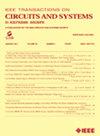A 22-nA Quiescent Current, 50-mA Output-Capacitor-Less Low-Dropout Regulator With Multiple-Feedback Loop for IoT Devices
IF 4
2区 工程技术
Q2 ENGINEERING, ELECTRICAL & ELECTRONIC
IEEE Transactions on Circuits and Systems II: Express Briefs
Pub Date : 2024-07-15
DOI:10.1109/TCSII.2024.3427832
引用次数: 0
Abstract
This brief presents an ultra-low power, output-capacitor-less low-dropout regulator (OCL-LDO) with a multiple-feedback loop (MFL) for Internet-of-Things (IoT) devices. The proposed LDO consists of five feedback loops that offer excellent steady-state and transient performance. A tri-loop flipped-voltage-follower (FVF) stage enhances both line and load regulation. The slew-rate enhancement loop based on source cross-coupled error amplifier (SXCEA) provides a fast transient response. Moreover, the proposed LDO utilizes a dynamic feedback loop that significantly improves the undershoot recovery time during the full load step current. The design was fabricated in a 65-nm low-power CMOS process and occupies an area of 0.025 mm2. The LDO can deliver a maximum of 50 mA load current at a 1 V output voltage and consume only 22 nA measured quiescent current. The measurement results show that the proposed LDO achieves a load regulation of 0.004 mV/mA and a low-frequency power supply rejection (PSR) at full load of −63.5 dB. For a load current step from 200 nA to 50 mA with a 10 ns edge time, the measured voltage undershoot is 574 mV and settles within 200 ns. We achieve a figure-of-merit of 0.5 fs.适用于物联网设备的静态电流为 22 毫安、输出电容为 50 毫安、具有多重反馈回路的无电容低压差稳压器
本简介为物联网(IoT)设备介绍了一种具有多重反馈回路(MFL)的超低功耗、无输出电容低压差稳压器(OCL-LDO)。拟议的 LDO 由五个反馈回路组成,具有出色的稳态和瞬态性能。三回路翻转电压跟随器(FVF)级增强了线路和负载调节能力。基于源交叉耦合误差放大器(SXCEA)的压摆率增强环路可提供快速的瞬态响应。此外,所提出的 LDO 利用动态反馈环路显著改善了满载阶跃电流期间的欠冲恢复时间。该设计采用 65 纳米低功耗 CMOS 工艺制造,占地面积为 0.025 平方毫米。该 LDO 可在 1 V 输出电压下提供最大 50 mA 负载电流,测量静态电流消耗仅为 22 nA。测量结果表明,这款 LDO 的负载调节能力为 0.004 mV/mA,满载时的低频电源抑制 (PSR) 为 -63.5 dB。负载电流阶跃从 200 nA 到 50 mA,边沿时间为 10 ns,测得的电压下冲为 574 mV,并在 200 ns 内稳定下来。我们实现了 0.5 fs 的性能指标。
本文章由计算机程序翻译,如有差异,请以英文原文为准。
求助全文
约1分钟内获得全文
求助全文
来源期刊
CiteScore
7.90
自引率
20.50%
发文量
883
审稿时长
3.0 months
期刊介绍:
TCAS II publishes brief papers in the field specified by the theory, analysis, design, and practical implementations of circuits, and the application of circuit techniques to systems and to signal processing. Included is the whole spectrum from basic scientific theory to industrial applications. The field of interest covered includes:
Circuits: Analog, Digital and Mixed Signal Circuits and Systems
Nonlinear Circuits and Systems, Integrated Sensors, MEMS and Systems on Chip, Nanoscale Circuits and Systems, Optoelectronic
Circuits and Systems, Power Electronics and Systems
Software for Analog-and-Logic Circuits and Systems
Control aspects of Circuits and Systems.

 求助内容:
求助内容: 应助结果提醒方式:
应助结果提醒方式:


